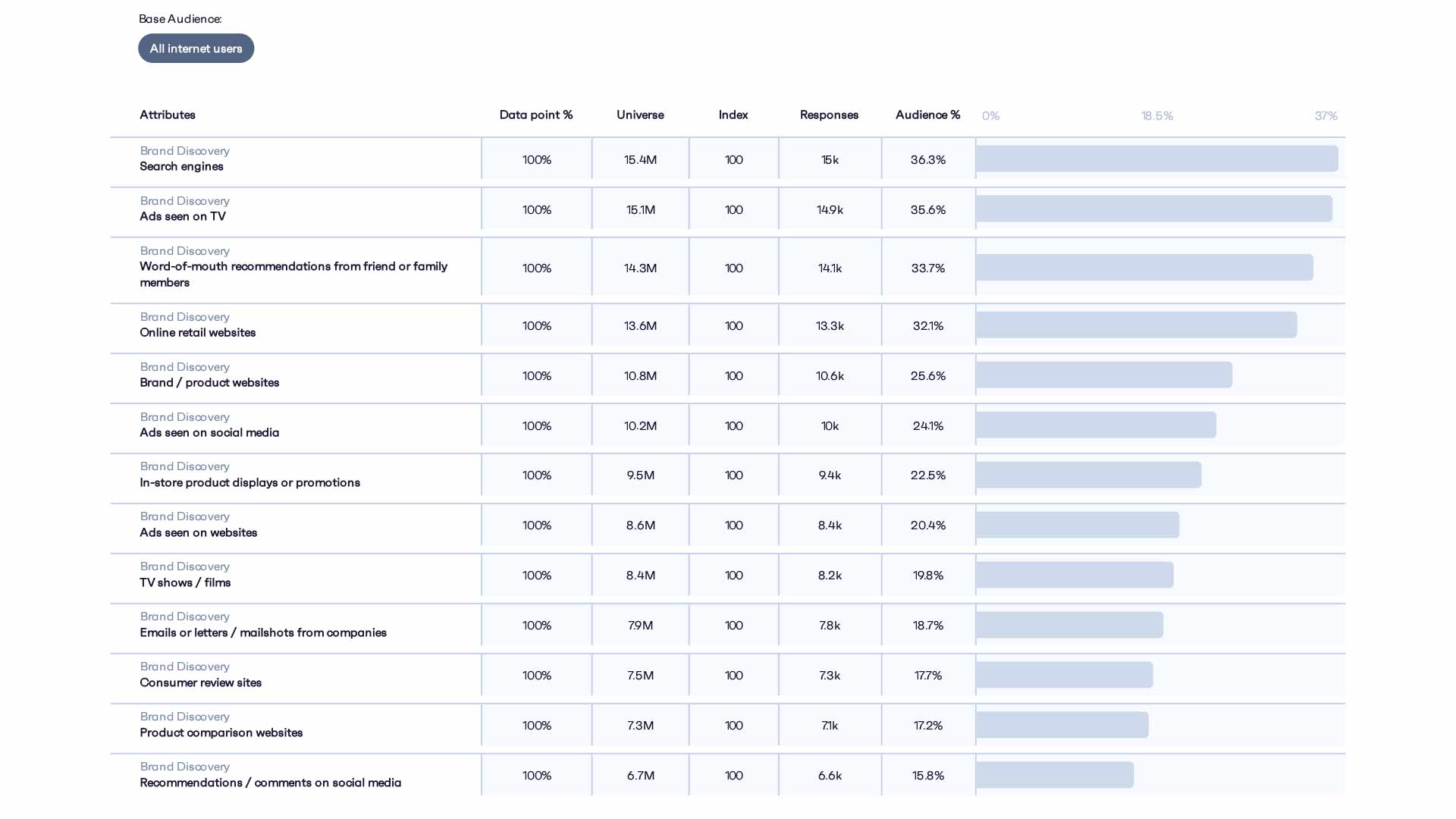FEATURED ARTICLE JULY 2023:
Marketing Channels: Consumer Brand Discovery
By HARRIETT TYPE, CLIENT SERVICES DIRECTOR

Marketing channels have evolved and diversified extensively in the last 20 years with the progression and development of digital channels, and with a profusion of social media sites to digital TV channels, retail comparison websites, entertainment sites, and so much more. Additionally, analysts now have more performance visibility than ever before, as tracking and research techniques have improved and developed.
For brands, it is critical that they understand both their target audience and the specific marketing channels they consume and are influenced by when those consumers want to find new brands and products. There are subtle nuances between the behaviours of segments divided by age, gender, or income, as just a few examples, and brands need to understand these differences in order to plan their campaign strategies to achieve the best possible results.
In a recent report published by GWI they asked a UK representative audience…
How do you typically find out about new brands and products?
A definition of brand discovery in simple terms is when a consumer is exposed to or finds a new brand, its product offering or its services.
1. Search engines (36.3%)
2. Ads seen on TV (35.6%)
3. Word-of-mouth recommendations from friends or family members (33.7%)
4. Online retail websites (32.1%)
5. Brand/product websites (25.6%)
6. Ads seen on social media (24.1%)
7. In-store product displays or promotions (22.5%)
8. Ads seen on websites (20.4%)
9. TV shows/films (19.8%)
10. Emails or letters/ mailshots from companies (18.7%)

Unsurprisingly, overall some of the least effective channels are virtual spaces, for example, VR/ AR, with just 3.1% of respondents claiming to have discovered brands through this medium. This is followed by ads on messaging apps at 5.1%, vlogs at 5.5% and then ads and sponsored content on podcasts at just 6.9%, plus endorsements by celebrities or well-known individuals, which is also just 6.9%.
Overall search engines have the top spot as the most popular consumer marketing channel for brand discovery. However, there is clear differentiation when it comes to different segments.
Brand Discovery by Age Group
Examining the results published by GWI for each age segment demonstrates how brands’ marketing strategy needs to be adapted for different customer groups.
16 to 24 Years Of Age:
Social media ads are the primary marketing channel for brand discovery, with 31.6% of this age group relying on them.
TV ads and online retail websites are also significant sources of brand information, with 24.9% of respondents using each of these channels.

25 to 34 Years Of Age:
Search engines become the leading channel for brand discovery in this age group, with 29.9% relying on them. TV ads remain influential, with 28% of respondents discovering brands through this medium. Social media ads are also popular, with 27.9% of individuals in this age bracket finding brands through these ads.

35 to 44 Years Of Age:
Search engines continue to dominate as the primary channel for brand discovery, with 36.3% of this age group relying on them.
TV ads maintain their importance, with 34.1% of respondents discovering brands through television. Word-of-mouth recommendations from friends and family also play a significant role, with 32.7% of individuals in this age bracket relying on them.

These findings suggest that younger age groups are more influenced by social media and online platforms for brand discovery, while search engines remain influential across all age segments. Additionally, word-of-mouth recommendations become more significant as individuals enter the 35 to 44-year-old age range. To effectively target different age groups, brands should tailor their marketing strategies to prioritise the channels that resonate most with each specific demographic.
45 to 54 Years Of Age:
Search engines remain the primary marketing channel for brand discovery, with 43.2% of this age group relying on them.
TV ads continue to be influential, with 42.3% of respondents discovering brands through television. Word-of-mouth recommendations from friends and family remain significant, with 39.8% of individuals in this age bracket relying on them.

55 to 64 Years Of Age:
Search engines continue to be the leading channel for brand discovery, with 42.2% of this age group relying on them. TV ads remain influential, with 40.7% of respondents discovering brands through television. Word-of-mouth recommendations from friends and family become even more important within this age group, with 38% of individuals relying on them.

These findings indicate that search engines and TV ads maintain their significance as age increases. Additionally, word-of-mouth recommendations from friends and family continue to play a crucial role in brand discovery as individuals get older. To effectively reach the 45 to 54 and 55 to 64 age groups, brands should prioritise search engine visibility and invest in TV advertising. Furthermore, fostering positive word-of-mouth experiences can have a significant impact on brand discovery within these age segments. Understanding these differences in channel preferences can help brands tailor their marketing efforts to effectively engage with their target audience in each age group.
For brands targeting high-income consumers a different approach will be needed compared to medium or low income.

High-Income Consumers:
High-income consumers have a different approach to brand discovery compared to medium or low-income groups.
They show lower reliance on traditional brand discovery channels like search engines, TV ads, social media ads, and word-of-mouth recommendations. Instead, high-income consumers have a higher propensity for brand discovery through consumer newspapers and articles, as well as websites.
To effectively target high-income consumers, brands should consider leveraging these channels to reach their intended audience.
Medium-Income Consumers:
Medium-income consumers exhibit a higher brand discovery through a mix of channels, including search engines, social media ads, TV ads, and word-of-mouth recommendations.
They also rely on online retail websites for brand discovery. Brands targeting medium-income groups should prioritise a multi-channel approach, focusing on search engines, social media, TV ads, and encouraging positive word-of-mouth experiences.
Low-Income Consumers:
Low-income consumers primarily rely on search engines, TV ads, and word-of-mouth recommendations from friends and family for brand discovery. These traditional channels play a significant role in reaching and engaging with the low-income consumer segment.
Brands aiming to target low-income consumers should focus on search engine visibility, investing in TV advertising, and fostering positive word-of-mouth referrals. Understanding the different brand discovery channels preferred by consumers across income brackets is crucial for brands to tailor their marketing strategies accordingly. By aligning their approach with the specific channels preferred by each income group, brands can effectively reach and engage their target audience.

Word-of-mouth recommendations from friends and family are the strongest channel for women when it comes to discovering new brands, with 38.6% relying on this source. In comparison, 28.8% of men find brand recommendations through word-of-mouth.
Ads seen on TV are another significant channel for brand discovery, with a slight gender bias towards women. Women are more likely to discover new brands through TV ads, with 36.8% relying on this channel, compared to 34.5% of men.
Search engines play a role in brand discovery for both men and women, but men tend to have a slightly stronger reliance on this channel. Approximately 37.7% of men find new brands through search engines, while 34.9% of women use this channel for brand discovery.
These findings suggest that women place a higher emphasis on word-of-mouth recommendations from friends and family as well as TV ads when it comes to discovering new brands. On the other hand, men show a slightly stronger preference for brand discovery through search engines.
Brands should consider these gender differences in brand discovery channels and tailor their marketing strategies accordingly. Fostering positive word-of-mouth experiences and utilising TV ads may be more effective in reaching and engaging with female consumers, while optimising search engine visibility can be beneficial for targeting male consumers.
Overall there are no dramatic revelations in brand discovery marketing channels. It is interesting to see that in general, regardless of their popularity, social media ads are not leading marketing channels compared to TV ads, word-of-mouth and search engine ads. Traditional media in terms of print media has been in decline for a number of years and the report reflects this downward trend. It will be interesting to note the progression of ads in virtual spaces including AR and VR as this medium goes from strength to strength and in gains traction amongst a wider audience.
Source Data: GWI
GOT AN ACTIVE PROJECT REQUIREMENT?
Get in touch today with our team today to take your brand’s success rate to the next level.
